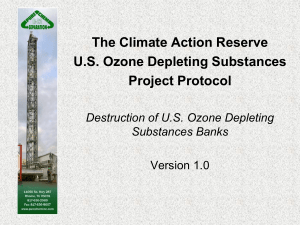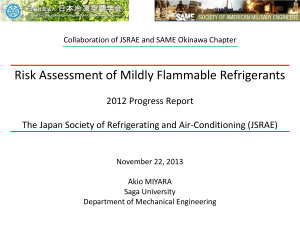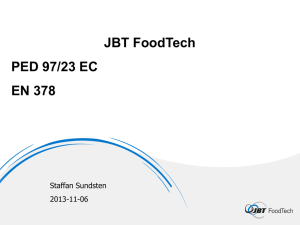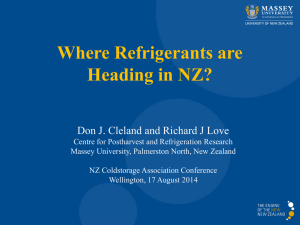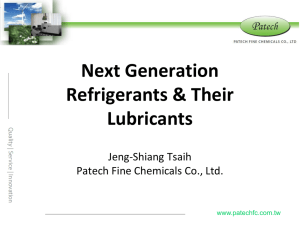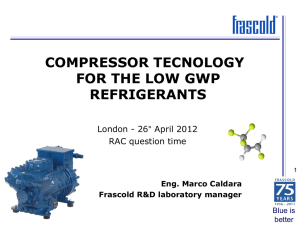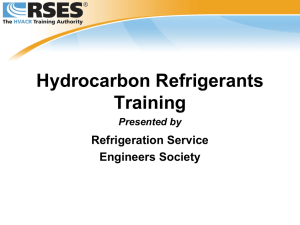Refrigrants
advertisement
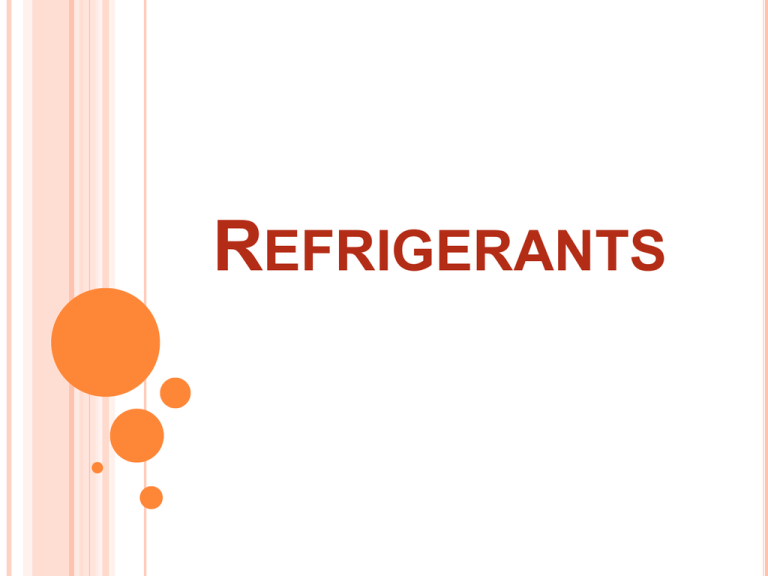
REFRIGERANTS The specific objectives of this lecture are to: 1. Discuss the importance of selection of suitable refrigerant in a refrigeration system. 2. Classify refrigerants into primary and secondary, and discuss the important differences between primary and secondary refrigerants. 3. Discuss refrigerant selection criteria based on thermodynamic, thermophysical, environmental and economic properties. 4. Describe the numbering system used for designating refrigerants. 5. Present a comparison between different refrigerants. At the end of the lecture, the student should be able to: 1. Explain the importance of refrigerant selection. 2. Differentiate between primary and secondary refrigerants. 3. List the criteria used in selecting refrigerants. 4. List important thermodynamic and environmental properties influencing refrigerant selection. 5. Write the chemical formula of a refrigerant from its number. 6. Compare different refrigerants and suggest replacements for CFCs and HCFCs. Introduction Refrigerant : is the primary working fluid used for absorbing and transmitting heat in a refrigeration system Refrigerants absorb heat at low temperature and low pressure and release heat at a higher temperature and pressure Most refrigerants undergo phase changes during heat absorption (evaporation) and heat releasing (condensation) Introduction….Continued The thermodynamic efficiency of a refrigeration system depends mainly on its operating temperatures. However, important practical issues such as the system design, size, initial and operating costs, safety, reliability, and serviceability etc. depend very much on the type of refrigerant selected for a given application. Due to several environmental issues such as ozone layer depletion, global warming and their relation to the various refrigerants used, the selection of suitable refrigerant has become one of the most important issues in recent times. Replacement of an existing refrigerant by a completely new refrigerant, for whatever reason, is an expensive proposition as it may call for several changes in the design and manufacturing of refrigeration systems. Hence it is very important to understand the issues related to the selection and use of refrigerants. In principle, any fluid can be used as a refrigerant. Air used in an air cycle refrigeration system can also be considered as a refrigerant. However, in this lecture the attention is mainly focused on those fluids that can be used as refrigerants in vapor compression refrigeration systems only. Primary and Secondary Refrigerants Fluids suitable for refrigeration purposes can be classified into primary and secondary refrigerants. Primary refrigerants are those fluids, which are used directly as working fluids, for example in vapor compression and vapor absorption refrigeration systems. When used in compression or absorption systems, these fluids provide refrigeration by undergoing a phase change process in the evaporator. As the name implies, secondary refrigerants are those liquids, which are used for transporting thermal energy from one location to other. Secondary refrigerants are also known under the name brines or antifreezes. Of course, if the operating temperatures are above 0oC, then pure water can also be used as secondary refrigerant, for example in large air conditioning systems. Antifreezes or brines are used when refrigeration is required at sub-zero temperatures. Unlike primary refrigerants, the secondary refrigerants do not undergo phase change as they transport energy from one location to other. Cooling Medium: is a working fluid cooled by the refrigerant to transport the cooling effect between a central plant and remot cooling units and terminals Chilled water, brine, and glycol are used as cooling media in many refrigeration systems. The cooling medium is often called a secondary refrigerant, because it reduces the extensive circulation of the primary refrigerant An important property of a secondary refrigerant is its freezing point. Generally, the freezing point of a brine will be lower than the freezing point of its constituents. The temperature at which freezing of a brine takes place depends on its concentration. The concentration at which a lowest temperature can be reached without solidification is called as eutectic point. The commonly used secondary refrigerants are the solutions of water and ethylene glycol, propylene glycol or calcium chloride. These solutions are known under the general name of brines. Essential Properties of Refrigerants Chemical stability under conditions of use is the most important characteristics Safety codes may require a nonflammable refrigerant of low toxicity for most applications Cost, availability, efficiency, and compatibility with compressor lubricants and materials with which the equipment is constructed are other concerns Latent heat of vaporization is another important property Physical Properties The refrigerants are arranged in increasing order of atmospheric boiling point, from air at -194.3 oC to water at 100 oC The boiling point is most important because it is a direct indicator of the temperature level at which a refrigerant can be used Physical Properties of Selected Refrigerants REFRIGERATION EFFECT AND UNIT OF REFRIGERATION The rate at which heat is absorbed from space to be cooled is termed as the refrigeration effect The refrigeration effect can be compared with the production of ice In the refrigeration industry, the unit used is ton A tone of refrigeration is equivalent to the rate of heat transfer needed to produce 1 ton of ice at 0 oC from water at 0 oC in 24 hours A machine capable of producing a net refrigeration effect of 210 kJ/min or 3.5 kW is called a 1 ton machine Refrigerant selection criteria: Selection of refrigerant for a particular application is based on the following requirements: I. Thermodynamic and thermo-physical properties. II. Environmental and safety properties, like: ozone depletion potential, global warming potential, and combustibility I. Economics. Thermodynamic and Thermo-physical Properties The requirements are: a) Suction pressure: At a given evaporator temperature, the saturation pressure should be above atmospheric for prevention of air or moisture and non-condensable gases ingress into the system and ease of leak detection. Higher suction pressure is better as it leads to smaller compressor displacement b) Discharge pressure: At a given condenser temperature, the discharge pressure should be as small as possible to allow light-weight construction of compressor, condenser , pipe, etc. c) Pressure ratio: Should be as small as possible for high volumetric efficiency and low power consumption d) Latent heat of vaporization: Should be as large as possible so that the required mass flow rate per unit cooling capacity will be small From the above equation, it can be seen that for given condenser and evaporator temperatures as the latent heat of vaporization increases, the pressure ratio also increases. Hence a trade-off is required between the latent heat of vaporization and pressure ratio. e) Isentropic index of compression: Should be as small as possible so that the temperature rise during compression will be small. f) Liquid specific heat: Should be small so that degree of subcooling will be large leading to smaller amount of flash gas at evaporator inlet g) Vapour specific heat: Should be large so that the degree of superheating will be small h) Thermal conductivity: Thermal conductivity in both liquid as well as vapor phase should be high for higher heat transfer coefficients i) Viscosity: Viscosity should be small in both liquid and vapor phases for smaller frictional pressure drops Environmental and Safety Properties In fact, at present the environment friendliness of the refrigerant is a major factor in deciding the usefulness of a particular refrigerant. The important environmental and safety properties are: a) Ozone Depletion Potential (ODP): According to the Montreal protocol, the ODP of refrigerants should be zero, i.e., they should be non-ozone depleting substances. Refrigerants having non-zero ODP have either already been phased-out (e.g. R 11, R 12) or will be phasedout in near-future(e.g. R22). Since ODP depends mainly on the presence of chlorine or bromine in the molecules, refrigerants having either chlorine (i.e., CFCs and HCFCs) or bromine cannot be used under the new regulations. b) Global Warming Potential (GWP): Refrigerants should have as low a GWP value as possible to minimize the problem of global warming. Refrigerants with zero ODP but a high value of GWP (e.g. R134a) are likely to be regulated in future. c) Total Equivalent Warming Index (TEWI): The factor TEWI considers both direct (due to release into atmosphere) and indirect (through energy consumption) contributions of refrigerants to global warming. Naturally, refrigerants with as a low a value of TEWI are preferable from global warming point of view. d) Toxicity: Ideally, refrigerants used in a refrigeration system should be non-toxic. However, all fluids other than air can be called as toxic as they will cause suffocation when their concentration is large enough. Thus toxicity is a relative term, which becomes meaningful only when the degree of concentration and time of exposure required to produce harmful effects are specified. Some fluids are toxic even in small concentrations. Some fluids are mildly toxic, i.e., they are dangerous only when the concentration is large and duration of exposure is long. Some refrigerants such as CFCs and HCFCs are nontoxic when mixed with air in normal condition. However, when they come in contact with an open flame or an electrical heating element, they decompose forming highly toxic elements (e.g. phosgene-COCl2). In general the degree of hazard depends on: Amount of refrigerant used vs total space Type of occupancy Presence of open flames Odor of refrigerant, and Maintenance condition e) Flammability: The refrigerants should preferably be nonflammable and non-explosive. For flammable refrigerants special precautions should be taken to avoid accidents. Based on the above criteria, ASHRAE has divided refrigerants into six safety groups (A1 to A3 and B1 to B3). Refrigerants belonging to Group A1 (e.g. R11, R12, R22, R134a, R744, R718) are least hazardous, while refrigerants belonging to Group B3 (e.g. R1140) are most hazardous. Economic properties: The refrigerant used should preferably be inexpensive and easily available. Designation of refrigerants: Figure shows the classification of fluids used as refrigerants in vapor compression refrigeration systems. Since a large number of refrigerants have been developed over the years for a wide variety of applications, a numbering system has been adopted to designate various refrigerants. From the number one can get some useful information about the type of refrigerant, its chemical composition, molecular weight etc. All the refrigerants are designated by R followed by a unique number. I. Fully saturated, halogenated compounds: These refrigerants are derivatives of alkanes (CnH2n+2) such as methane (CH4), ethane (C2H6). These refrigerants are designated by R XYZ, where: X+1 indicates the number of Carbon (C) atoms Y-1 indicates number of Hydrogen (H) atoms, and Z indicates number of Fluorine (F) atoms The balance indicates the number of Chlorine atoms. Only 2 digits indicates that the value of X is zero. Ex: R 22 X = 0 ⇒ No. of Carbon atoms = 0+1 = 1 ⇒ derivative of methane (CH4) Y = 2 ⇒ No. of Hydrogen atoms = 2-1 = 1 Z = 2 ⇒ No. of Fluorine atoms = 2 The balance = 4 – no. of (H+F) atoms = 4-1-2 = 1 ⇒ No. of Chlorine atoms = 1 ∴The chemical formula of R 22 = CHClF2 Similarly it can be shown that the chemical formula of: • R12 = CCl2F2 • R134a = C2H2F4 (derivative of ethane) (letter a stands for isomer, e.g. molecules having same chemical composition but different atomic arrangement, e.g. R134 and R134a) II. Inorganic refrigerants: These are designated by number 7 followed by the molecular weight of the refrigerant (rounded-off). Ex.: Ammonia: Molecular weight is 17, ∴ the designation is R 717 Carbon dioxide: Molecular weight is 44, ∴ the designation is R 744 Water: Molecular weight is 18, ∴ the designation is R 718 III. Mixtures: Azeotropic mixtures are designated by 500 series, where as zeotropic refrigerants (e.g. nonazeotropic mixtures) are designated by 400 series. Azeotropic mixtures: R 500: Mixture of R 12 (73.8 %) and R 152a (26.2%) R 502: Mixture of R 22 (48.8 %) and R 115 (51.2%) R503: Mixture of R 23 (40.1 %) and R 13 (59.9%) R507A: Mixture of R 125 (50%) and R 143a (50%) Zeotropic mixtures: R404A : Mixture of R 125 (44%), R 143a (52%) and R 134a (4%) R407A : Mixture of R 32 (20%), R 125 (40%) and R 134a (40%) R407B : Mixture of R 32 (10%), R 125 (70%) and R 134a (20%) R410A : Mixture of R 32 (50%) and R 125 (50%) Hydrocarbons: Propane (C3H8) : R 290 n-butane (C4H10) : R 600 iso-butane (C4H10) : R 600a Unsaturated Hydrocarbons: R1150 (C2H4) R1270 (C3H6) Comparison between Different Refrigerants Synthetic refrigerants that were commonly used for refrigeration, cold storage and air conditioning applications are: R 11 (CFC 11), R 12 (CFC 12), R 22 (HCFC 22), R 502 (CFC 12+HCFC 22) etc. However, these refrigerants have to be phased out due to their Ozone Depletion Potential (ODP). The synthetic replacements for the older refrigerants are: R134a (HFC-134a) and blends of HFCs. Generally, synthetic refrigerants are non-toxic and nonflammable. However, compared to the natural refrigerants the synthetic refrigerants offer lower performance and they also have higher Global Warming Potential (GWP). As a result, the synthetic refrigerants face an uncertain future. The most commonly used natural refrigerant is ammonia. This is also one of the oldest known refrigerants. Ammonia has good thermodynamic, thermophysical and environmental properties. However, it is toxic and is not compatible with some of the common materials of construction such as copper, which somewhat restricts its application. Other natural refrigerants that are being suggested are hydrocarbons (HCs) and carbon di-oxide (R-744). Though these refrigerants have some specific problems owing to their eco-friendliness, they are being studied widely and are likely to play a prominent role in future. Prior to the environmental issues of ozone layer depletion and global warming, the most widely used refrigerants were: R 11, R 12, R 22, R 502 and ammonia. Of these, R 11 was primarily used with centrifugal compressors in air conditioning applications. R 12 was used primarily in small capacity refrigeration and cold storage applications, while the other refrigerants were used in large systems such as large air conditioning plants or cold storages. Among the refrigerants used, except ammonia, all the other refrigerants are synthetic refrigerants and are non-toxic and non-flammable. Though ammonia is toxic, it has been very widely used due to its excellent thermodynamic and thermophysical properties. The scenario changed completely after the discovery of ozone layer depletion in 1974. The depletion of stratospheric ozone layer was attributed to chlorine and bromine containing chemicals such as Halons, CFCs, HCFCs etc. Since ozone layer depletion could lead to catastrophe on a global level, it has been agreed by the global community to phase out the ozone depleting substances (ODS). As a result except ammonia, all the other refrigerants used in cold storages had to be phased-out and a search for suitable replacements began in earnest. At the same time, it was also observed that in addition to ozone layer depletion, most of the conventional synthetic refrigerants also cause significant global warming. In view of the environmental problems caused by the synthetic refrigerants, opinions differed on replacements for conventional refrigerants. The alternate refrigerants can be classified into two broad groups: I. Non-ODS, synthetic refrigerants based on Hydro-FluoroCarbons (HFCs) and their blends II. Natural refrigerants including ammonia, carbon dioxide, hydrocarbons and their blends Exercise 1. 2. 3. 4. 5. 6. 7. Advantages and disadvantages of differnt types of Fluorinated refrigerants Advantages and disadvantages of Ammonia refigerant and its application Primary and Secondary refrigerants, characteristics of secondary refrigerants comparision with other two refrigerant types Thermodynamic and thermo-physical properties of refrigerant Comparison between different refrigerants Environmental and safety properties of refrigerants Essential properties of refrigerants Questions and answers: 1. Which of the following statements are TRUE? a) A primary refrigerant does not undergo phase change in a refrigeration cycle b) A secondary refrigerant does not undergo phase change in a refrigeration cycle c) The freezing point of a brine is generally lower than the freezing point of its constituents d) The freezing point of a brine is generally higher than the freezing point of its constituents 2. Which of the following statements are TRUE? a) The suction pressure of a refrigerant should be as high as possible b) The suction pressure of a refrigerant should be as low as possible c) The discharge pressure of a refrigerant should be as high as possible d) The discharge pressure of a refrigerant should be as low as possible 3) Which of the following statements are TRUE? a) At a given temperature, as the latent heat of vaporization increases, the saturation pressure decreases b) For given evaporator and condenser temperatures, as the latent heat of vaporization increases, the pressure ratio decreases c) As the latent heat of vaporization increases, the required mass flow rate of refrigerant, becomes smaller for a given capacity d) For a given pressure ratio, as the isentropic index of compression increases, the compressor discharge temperature increases 4) Which of the following statements are TRUE? a) A refrigerant having high critical temperature yields high COP and high volumetric capacity b) A refrigerant having high critical temperature yields low COP and high volumetric capacity c) A refrigerant having high critical temperature yields low COP and low volumetric capacity d) A refrigerant having high critical temperature yields high COP and low volumetric capacity 5) Which of the following statements are TRUE? a) Low molecular weight refrigerants have high latent heat of vaporization b) Low molecular weight refrigerants have low latent heat of vaporization c) For saturated state at the inlet to the compressor, a refrigerant having high vapor specific heat may give rise to wet compression d) For saturated state at the inlet to the compressor, a refrigerant having low vapor specific heat may give rise to wet compression 6) 6. The chemical formula of refrigerant R11 is: a) b) c) d) CCl3F CClF3 CClHF CHF 7) The chemical formula of R141 is: a) b) c) d) C2H3ClF3 C2H2Cl3F C2H3Cl2F C2H2ClF3 8) Which of the following statements is TRUE? a) Evaporation process is non-isothermal for zeotropic mixtures b) Evaporation process is non-isothermal for azeotropic mixtures c) Composition of azeotropic mixture changes in the event of a leak d) Composition of zeotropic mixture changes in the event of a leak 9) Which of the following refrigerants are phased-out due to Montreal protocol on ozone layer depletion a) b) c) d) R11 R21 R12 R32 10) Which of the following refrigerants replace R12 in domestic refrigerators? a) b) c) d) R22 R11 R134a R141b 11) Which of the following refrigerants are suggested as replacements for R22 in large air conditioning and cold storage systems? a) b) c) d) R134a R21 R410A R407C

